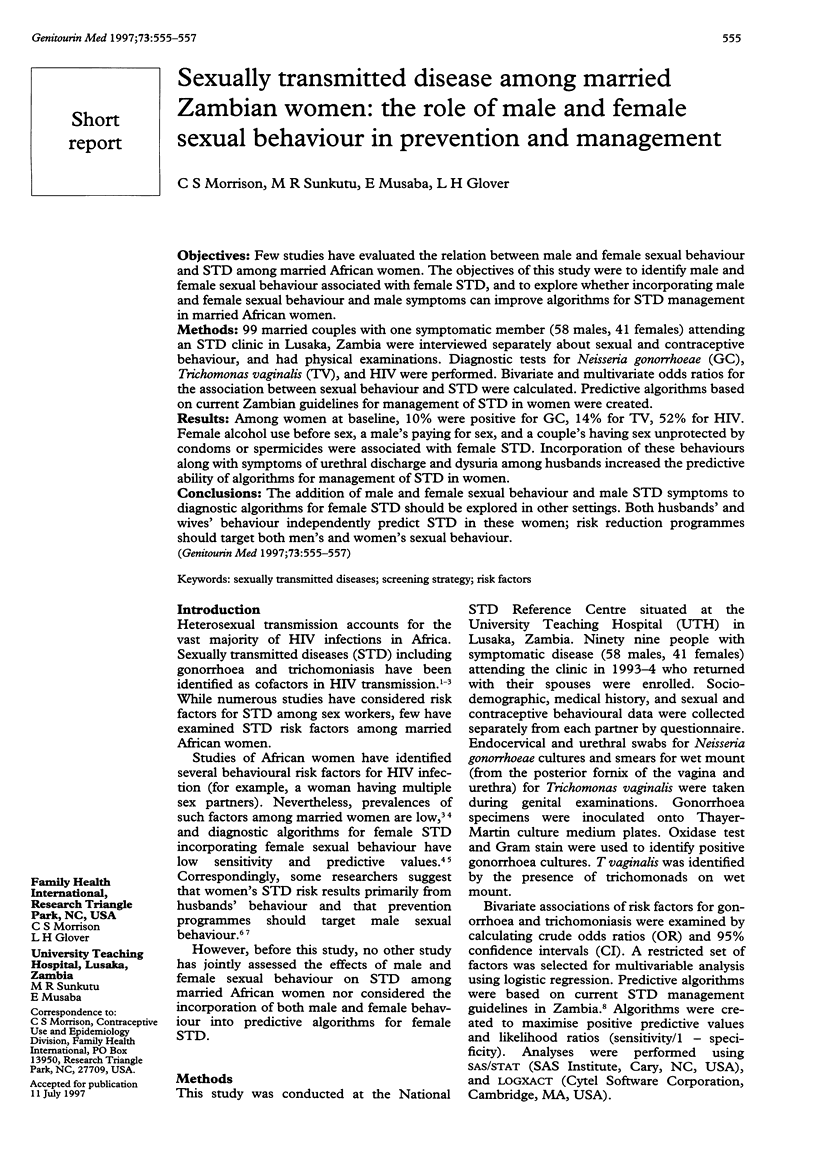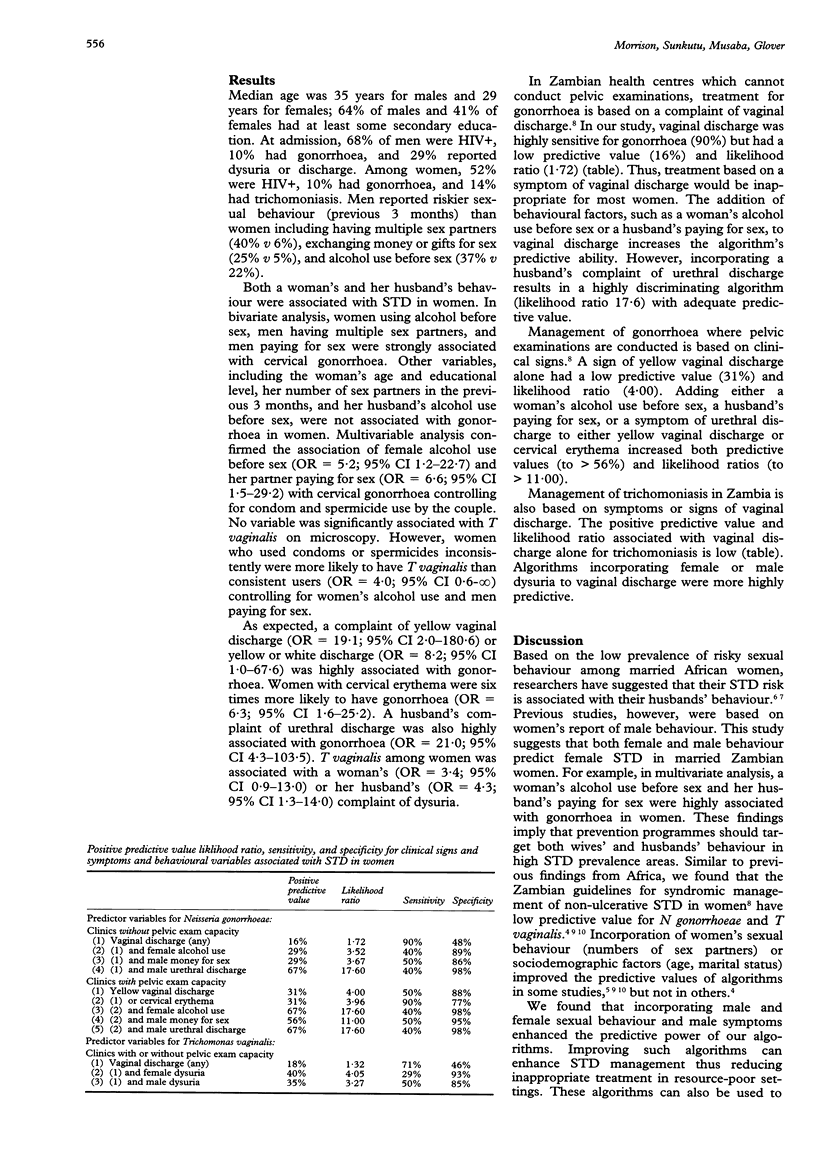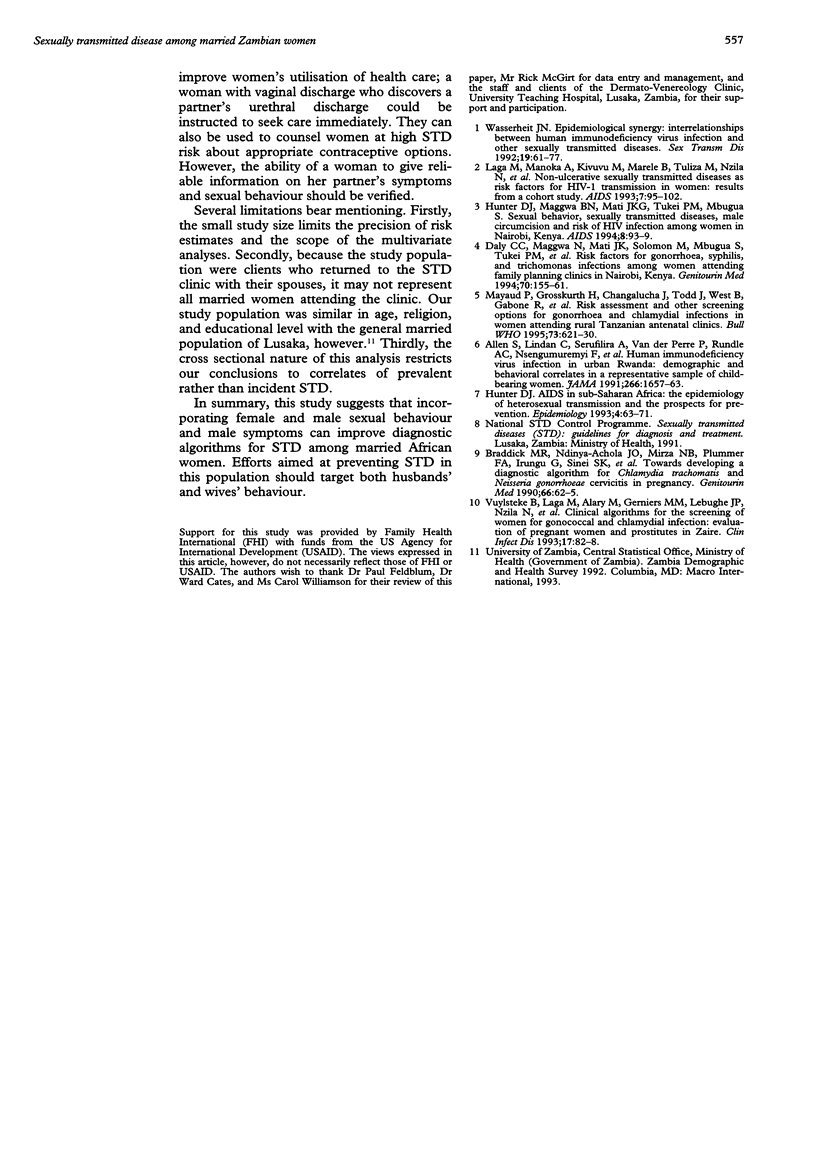Abstract
OBJECTIVES: Few studies have evaluated the relation between male and female sexual behaviour and STD among married African women. The objectives of this study were to identify male and female sexual behaviour associated with female STD, and to explore whether incorporating male and female sexual behaviour and male symptoms can improve algorithms for STD management in married African women. METHODS: 99 married couples with one symptomatic member (58 males, 41 females) attending an STD clinic in Lusaka, Zambia were interviewed separately about sexual and contraceptive behaviour, and had physical examinations. Diagnostic tests for Neisseria gonorrhoeae (GC), Trichomonas vaginalis (TV), and HIV were performed. Bivariate and multivariate odds ratios for the association between sexual behaviour and STD were calculated. Predictive algorithms based on current Zambian guidelines for management of STD in women were created. RESULTS: Among women at baseline, 10% were positive for GC, 14% for TV, 52% for HIV. Female alcohol use before sex, a male's paying for sex, and a couple's having sex unprotected by condoms or spermicides were associated with female STD. Incorporation of these behaviours along with symptoms of urethral discharge and dysuria among husbands increased the predictive ability of algorithms for management of STD in women. CONCLUSIONS: The addition of male and female sexual behaviour and male STD symptoms to diagnostic algorithms for female STD should be explored in other settings. Both husbands' and wives' behaviour independently predict STD in these women; risk reduction programmes should target both men's and women's sexual behaviour.
Full text
PDF


Selected References
These references are in PubMed. This may not be the complete list of references from this article.
- Braddick M. R., Ndinya-Achola J. O., Mirza N. B., Plummer F. A., Irungu G., Sinei S. K., Piot P. Towards developing a diagnostic algorithm for Chlamydia trachomatis and Neisseria gonorrhoeae cervicitis in pregnancy. Genitourin Med. 1990 Apr;66(2):62–65. doi: 10.1136/sti.66.2.62. [DOI] [PMC free article] [PubMed] [Google Scholar]
- Daly C. C., Maggwa N., Mati J. K., Solomon M., Mbugua S., Tukei P. M., Hunter D. J. Risk factors for gonorrhoea, syphilis, and trichomonas infections among women attending family planning clinics in Nairobi, Kenya. Genitourin Med. 1994 Jun;70(3):155–161. doi: 10.1136/sti.70.3.155. [DOI] [PMC free article] [PubMed] [Google Scholar]
- Hunter D. J. AIDS in sub-Saharan Africa: the epidemiology of heterosexual transmission and the prospects for prevention. Epidemiology. 1993 Jan;4(1):63–72. [PubMed] [Google Scholar]
- Hunter D. J., Maggwa B. N., Mati J. K., Tukei P. M., Mbugua S. Sexual behavior, sexually transmitted diseases, male circumcision and risk of HIV infection among women in Nairobi, Kenya. AIDS. 1994 Jan;8(1):93–99. doi: 10.1097/00002030-199401000-00014. [DOI] [PubMed] [Google Scholar]
- Laga M., Manoka A., Kivuvu M., Malele B., Tuliza M., Nzila N., Goeman J., Behets F., Batter V., Alary M. Non-ulcerative sexually transmitted diseases as risk factors for HIV-1 transmission in women: results from a cohort study. AIDS. 1993 Jan;7(1):95–102. doi: 10.1097/00002030-199301000-00015. [DOI] [PubMed] [Google Scholar]
- Mayaud P., Grosskurth H., Changalucha J., Todd J., West B., Gabone R., Senkoro K., Rusizoka M., Laga M., Hayes R. Risk assessment and other screening options for gonorrhoea and chlamydial infections in women attending rural Tanzanian antenatal clinics. Bull World Health Organ. 1995;73(5):621–630. [PMC free article] [PubMed] [Google Scholar]
- Vuylsteke B., Laga M., Alary M., Gerniers M. M., Lebughe J. P., Nzila N., Behets F., Van Dyck E., Piot P. Clinical algorithms for the screening of women for gonococcal and chlamydial infection: evaluation of pregnant women and prostitutes in Zaire. Clin Infect Dis. 1993 Jul;17(1):82–88. doi: 10.1093/clinids/17.1.82. [DOI] [PubMed] [Google Scholar]
- Wasserheit J. N. Epidemiological synergy. Interrelationships between human immunodeficiency virus infection and other sexually transmitted diseases. Sex Transm Dis. 1992 Mar-Apr;19(2):61–77. [PubMed] [Google Scholar]


